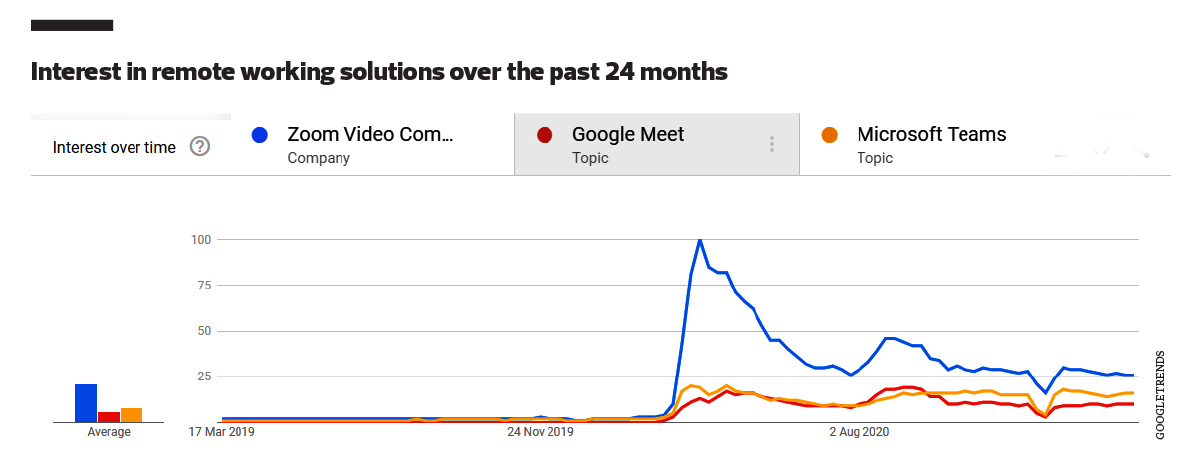
This article first appeared in Digital Edge, The Edge Malaysia Weekly on March 22, 2021 - March 28, 2021
Remote working solutions have been on the rise during the pandemic, as companies look to implement work-from-home (WFH) arrangements within a short period of time. A quick search on Google Trends shows that interest in such solutions peaked in April 2020 at the height of the pandemic, followed by a renewed interest in early September.
However, with vaccination programmes being rolled out in several major countries around the world, employers are asking their staff to return to the workplace or adopt a hybrid working arrangement.
What does the future of work look like, and how will remote working solution providers adapt to this second shift?
Hybrid working status quo
Despite companies returning to an office environment, Zoom’s head of international Abe Smith says many of the remote working implementations will still see widespread use post-pandemic as Covid-19 has merely accelerated the adoption of these tools.
“While companies seem to be testing the viability of a hybrid model as vaccines become readily available, 85% of local workers have expressed interest in continuing to work from home in some capacity, while 64% felt more productive working from home. These statistics should not be ignored as companies decide whether they will make a return to the old norm or adopt a hybrid model,” he says.
“Many companies foresee flexible working becoming a permanent fixture, and many have come forward to show their support for a hybrid model of work, where video-conferencing lies at the core.
“Twitter has stated that employees can work from home indefinitely while Mastercard has stated that employees can work remotely for as long as they want. Recently, HSBC announced plans to halve its office space globally over the long term, signifying plans to adopt a hybrid model of work even as the pandemic fades away.”
Smith explains that Zoom saw a massive surge in users during the pandemic, with use of the Zoom video conferencing platform growing from 10 million daily meeting participants in December 2019 to 300 million in April 2020.
“The pandemic came as a jolt for Zoom. We saw a tremendous influx of new and varied users joining the platform. Initially, we needed to work around the clock to ensure that businesses, schools, government agencies and many more organisations worldwide could remain connected and operational during the pandemic.
“Now that we have a variety of use cases, there is also the challenge of engaging these new users and creating a brand experience that is right for them. To achieve this, we regularly seek feedback from our users — and this has led to things like the addition of filters and stickers to video calls, as well as new offerings such as OnZoom and Zoom Apps, all of which are aimed at improving the in-meeting experience for our users,” he says.
Smith observes that organisations are now shifting from addressing their immediate business continuity needs to supporting a future where people are able to work and learn anywhere, by connecting to platforms such as Zoom.
He strongly believes that since the founding of Zoom in 2011, video communication has been a technology of the future, and the pandemic has shown that WFH is not just feasible, but also productive.
“For a diverse, fragmented region such as Southeast Asia, this presents greater connectivity so that businesses can expand within the region and perhaps even beyond, with sales and support teams on the ground.”
However, this new working environment also presents new challenges for companies such as Zoom. Smith explains that businesses are still in the midst of adapting to a hybrid working model despite having a “trial run” during the pandemic.
Many businesses may still be doubtful about adopting a hybrid working model for the long term as they move into unfamiliar territory and hope to maximise their post-pandemic recovery, he elaborates.
“As businesses have become more video-first and meeting-centric in terms of communication, they have also found that existing enterprise phone systems are unable to support this transition. As a result, there has been a strong demand for a simplified telephone system that is integrated into existing video conferencing software, enabling remote users to remain mobile.
“To support organisations’ shift towards a hybrid work model, Zoom released various features designed to enable them to build a ‘work from anywhere’ plan that puts employee health and safety at the centre of their strategy.
“We also rolled out solutions like Zoom Webinars that came packed with features you would find at regular webinars, such as registration options with reminders and follow-up emails, reporting, Q&A sessions, polling, the raise hand feature, MP4/M4A recording with transcripts and added streaming capabilities.”
Four key trends in work arrangements
Marc Woo, managing director of Google Malaysia, believes that the hybrid working arrangement will be the status quo in the future, although it may not apply to all jobs and sectors. He explains that employees in sectors such as manufacturing will still be required to work at the office.
However, the pandemic has shown that many employees are able to get work done at home, and it is no longer taboo to do so. Woo says that working culture rather than office space should define the company’s identity.
“To really drive both options — working from home and at the office — employers need to provide both financial and cultural support. An example of financial support would be offering to pay for their work-from-home set-up [such as webcams, microphones or computer systems].
“It is also important for employers to understand the importance of caring for family members and old folks at home. This is why we also provide extended carer’s leave, so that employees are able to take time off to take care of someone at home,” Woo says.
He also believes that there will be four key working arrangement trends in a post-pandemic environment. First, there will be a more varied form of communication within the workplace that extends beyond face-to-face communications.
“What the pandemic has allowed us to do, is have one-to-one and one-to-many forums happen through multiple mediums, such as Google Chats or any other video chatting tool. We also noticed that the workplace gets more productive.
“Workers now prefer spontaneous pings rather than notifying people after walking from one department to the next, and it allows employers to be more deliberate in scheduling time with the employees,” Woo says.
He also believes that hybrid onboarding will be the norm. Google hired thousands of new employees in 2020, and Woo says hiring post-pandemic poses a great challenge in terms of onboarding “new Googlers”, or “Nooglers”, as they are known within the company.
Hence, the company held meaningful virtual engagements and fun activities to help Nooglers get to know the company better. Woo also explains that they have a virtual buddy system to ensure that newcomers do not fully miss out on the immersive onboarding experience.
“Thirdly, there will be more experimentation in terms of employee engagement — the continued testing of boundaries transitioning from a pure virtual engagement model to a hybrid working model.
“Finally, there will be more diversity and inclusion within the workplace. It should be more than just lip service, and companies can start by focusing on small tweaks, such as allowing all participants to speak up and share their opinions.
“With video conferencing, this is even more pronounced now because there will be only one person talking in a virtual meeting, and people are more conscious that everyone needs to have a voice in these new mediums as well. It is not just a trend because we also noticed that diversity and inclusions lead to better employee productivity and overall business performance.”
More than just communication
According to Chong Kai Wooi, managing director of NEC Corporation of Malaysia, larger multinational corporations had been trying to implement remote working infrastructure even before the pandemic.
NEC, a Japanese corporation with a history of more than 120 years, is an end-to-end IT solutions provider that has also offered remote working solutions during the pandemic. Chong says remote working solutions are representative of the strong Japanese work ethics, enabling employees to work anytime, anywhere.
Although its communication solutions were one of the company’s more popular solutions during the pandemic, Chong highlights that the ability to communicate with one another is not enough to establish a productive workforce. The ability to access working applications is also a high priority, he points out.
“For the better part of the last decade, we have been helping customers virtualise their infrastructure and improve employee productivity. In the past, you could only access your work documents via a desktop or laptop. But today, you can access your work applications via your smartphones through the cloud,” he says.
“That is why we provide services such as migrating applications to the cloud, and to do so securely. From the way we look at it, organisations had already started this digitalisation process way before the pandemic, and those who had done so were more resilient during the pandemic.”
Chong believes there are growth opportunities in this area post-pandemic because many organisations have yet to fully adopt the digitalisation process and are still looking into improving their infrastructure.
“The companies that have survived the pandemic are the ones that have accelerated their growth as much as they can. They tend to be aggressive, fast to enter the market and are prudent in terms of costs.
“Right now, having a state-of-the-art office environment may not be their immediate priority. The ability to work anytime and anywhere is more important for both the employees and employers, so that is why they have invested in all these digital technologies and provided training for their employees.”
Chong adds that growth opportunities will vary according to the industry. For example, engineers will benefit more from remote working solutions because there are plenty of tasks that can be completed on-site rather than by returning to the office.
However, he also points out the importance of the digitalisation trifecta — technology, people and process.
He explains that technology has always been available, and it matured during the pandemic. In terms of people, employers should focus on how to continually engage with employees who are working remotely and ensure that they have the proper training and tools.
This process, Chong explains, is the hardest to execute properly because it tends to involve third parties and sometimes requires a fundamental change within the entire organisation. He gives the example of banking services, which require physical hand signatures for compliance purposes despite the companies adopting digital signatures.
For 2021, Chong says NEC will focus its efforts on the remote working section of the business, as well as other growth areas such as facial recognition software and touchless technologies.
He points out, however, that digitalisation and infrastructure will still be the main staple of the business, as remote working cannot be conducted efficiently if working applications are not digitalised and the infrastructure not properly secured.
“We provide end-to-end solutions, from migrating customers’ working applications to the cloud, making them available on an open platform, to providing them ICT tools. This is so their infrastructure is robust enough to support online conferencing, allow multiple collaborations on the same document and more. That would be our top priority for now, to enable remote workers and help them bridge the gap from the technology, people and process perspective,” he concludes.
Save by subscribing to us for your print and/or digital copy.
P/S: The Edge is also available on Apple's App Store and Android's Google Play.
- MetMalaysia can issue quake warnings within eight minutes, says DG
- Businessman with 'Tan Sri' title, said to be O&G industry veteran, arrested for RM10m scam
- Trump pressing advisers for tariff escalation ahead of April 2, Washington Post reports
- Myanmar hit by fresh 5.1 aftershock, tremors felt in neighbouring countries
- Indonesian Muslims to celebrate Eid on Monday
- Ukraine to seek more US investments in talks over economic deal — Bloomberg
- Businessman with 'Tan Sri' title, said to be O&G industry veteran, arrested for RM10m scam
- Indonesian Muslims to celebrate Eid on Monday
- Myanmar hit by fresh 5.1 aftershock, tremors felt in neighbouring countries
- Myanmar's quake toll passes 1,000 as foreign rescue teams arrive




